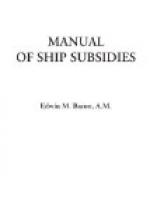The Admiralty’s favoritism toward the Cunard associates aroused a protest from the unsuccessful bidders for the subsidy, and at length the Great Western Company, whose bid had been the lowest, caused a Parliamentary inquiry to be made into the transaction. They complained that a monopoly had been granted “to their injury and to that of other owners of steamships engaged in the trade, and who were desirous of entering it”; and they asked the inquiry on the broad grounds “that the public were taxed for a service from which one company alone derived the advantage, and which could be equally well done and at less expense if mails were sent out by all steamers engaged in the trade, each receiving a certain amount percentage on the letters they carried."[Z] Although the fact was brought out in the testimony that the Great Western Company had offered to perform the service on practically the same basis as the Cunard associates, and that afterwards the Great Western had proposed to do it at half the subsidy to the Cunarders, the investigating committee sustained the Admiralty’s action.[AA]
The Great Western Company overcame the advantage of the Cunarders in the latter’s high mail subsidy by increased enterprise and superior management; and prospered. In 1843 they launched the Great Britain, the largest and finest steamship up to that period built for overseas service.[AB] She was, moreover, distinguished as the first liner to be built of iron instead of wood, and to be propelled by the screw instead of the paddle-wheel. In the latter innovation, however, she was not the pioneer. Again the Americans were first in the application of the auxiliary screw to ocean navigation,[AC] as they had been first in despatching a steamer across the Atlantic.
The initial transatlantic subsidy to the Cunard Company was followed up in 1840 and 1841 with contracts for steam mail-carriage to the West Indies and South American ports.[AD] The first (1840) went to the Royal Mail Steam Packet Company, for the West Indian service, the mail subsidy fixed at two hundred and forty thousand pounds a year;[AE] the second (1841), to the Pacific Steam Navigation Company. The latter enterprise was promoted by an American,[AF] after he had failed to obtain support in his own country[AG] for a project to establish an American steamship line to ports along the west coast of South America, a field in which American sailing ships had long been preeminent.[AH]




